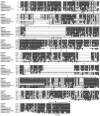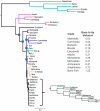AEG-1/MTDH/LYRIC, the beginning: initial cloning, structure, expression profile, and regulation of expression
- PMID: 23889986
- PMCID: PMC3930353
- DOI: 10.1016/B978-0-12-401676-7.00001-2
AEG-1/MTDH/LYRIC, the beginning: initial cloning, structure, expression profile, and regulation of expression
Abstract
Since its initial identification as a HIV-1-inducible gene in 2002, astrocyte elevated gene-1 (AEG-1), subsequently cloned as metadherin (MTDH) and lysine-rich CEACAM1 coisolated (LYRIC), has emerged over the past 10 years as an important oncogene providing a valuable prognostic marker in patients with various cancers. Recent studies demonstrate that AEG-1/MTDH/LYRIC is a pleiotropic protein that can localize in the cell membrane, cytoplasm, endoplasmic reticulum (ER), nucleus, and nucleolus, and contributes to diverse signaling pathways such as PI3K-AKT, NF-κB, MAPK, and Wnt. In addition to tumorigenesis, this multifunctional protein is implicated in various physiological and pathological processes including development, neurodegeneration, and inflammation. The present review focuses on the discovery of AEG-1/MTDH/LYRIC and conceptualizes areas of future direction for this intriguing gene. We begin by describing how AEG-1, MTDH, and LYRIC were initially identified by different research groups and then discuss AEG-1 structure, functions, localization, and evolution. We conclude with a discussion of the expression profile of AEG-1/MTDH/LYRIC in the context of cancer, neurological disorders, inflammation, and embryogenesis, and discuss how AEG-1/MTDH/LYRIC is regulated. This introductory discussion of AEG-1/MTDH/LYRIC will serve as the basis for the detailed discussions in other chapters of the unique properties of this intriguing molecule.
Keywords: AEG-1/MTDH/LYRIC; Cloning; HIV; Ha-ras; PI3K/AKT; c-Myc.
Copyright © 2013 Elsevier Inc. All rights reserved.
Figures



References
Publication types
MeSH terms
Substances
Grants and funding
LinkOut - more resources
Full Text Sources
Other Literature Sources
Research Materials
Miscellaneous

